 At the beginning of last school year I was in a discussion with my principal about how to raise our state standardized test scores. I told her that I knew how to raise the scores. It was simple, really. As math teachers, we just needed to continuously have students practice the key math concepts covered by the all-powerful state test. It was all a matter of repetition.
At the beginning of last school year I was in a discussion with my principal about how to raise our state standardized test scores. I told her that I knew how to raise the scores. It was simple, really. As math teachers, we just needed to continuously have students practice the key math concepts covered by the all-powerful state test. It was all a matter of repetition.
Now I am not a big fan of teaching to the test but if my boss (the state) has determined that 7th graders are responsible to know a certain body of mathematical knowledge before they leave my classroom, then by-golly I am going to try my best to get them there.
As I shared my keen insight with the principal, she looked at me and asked if I had been talking to our math department chairmen. I hadn’t. It turns out that we had just decided to purchase a rather expensive daily warmup program to use with our students.
What would this warmup program do? It would offer repeated exposure to the most important math concepts in the 7th grade state standards. These warmups are strongly correlated with the standards, have been field-tested, and proven to increase the results of students on our state test.
Just Common Sense?
This all made perfect sense to me. If I want my students to know how to use the Pythagorean Theorem to determine the unknown length of one side of a right triangle, it stands to reason that they will be more successful if they have seen the concept 10 times over the course of the year rather than two times. That’s not rocket science.
What I Used To Do
In the past, I have worked hard to teach a concept when it appeared in my curriculum. Then, a week or two before the test, I had crammed three-quarters of a year’s material into a multi-day review session. That was it. My students often saw the concepts twice, once when I taught it and once more right before the test. Needless to say, this was not the most effective way to offer students multiple opportunities to demonstrate mastery of the key math standards.
What I Do Now
Now I spend the first few minutes of each class period giving the students 5 warmup problems that help spiral our state grade-level standards. Students are given the opportunity to practice using the skills that they have previously learned in the context of the given word problems. The see the key standards over and over again during the course of the 130-day warmup program.
Sometimes the students are given problems that we have not yet reached in the sequence of our math text. As students correct their warmups, I present a brief explanation of the solutions to these problems. I realize that not every student will master the new concept in that mini-lesson, but some will. The next time that particualar type of problem is given, more students will be successful than before.
By the time I taught Pythagorean Theorem last year, my students had no trouble picking out the Pythagorean Triples and using them to solve for the missing side length of a right triangle. This concept had been presented over and over again in our warmup program.
The Results
My teaching colleague (Jason) and I were discussing our results today. Even though we did not begin using our new warmup program until about the second semester, our grade level percentage of students that were proficient or advanced on the state standardized test increased by 16% last year. This was one of the largest increases in our school district.
I realize that our new warmup program was only one factor in the increase of proficient/advanced students, but I know that it was one of the biggest factors in our success. I like to think that Jason and I, and the rest of our team, did a fantastic job teaching as well.
Why is a Review Program So Influential?
As we discussed this question, Jason said he believed that the repeated practice helped our students to RECOGNIZE different types of problems. Sometimes students who have strong math skills will still have difficulty applying them to new problem situations. The warmup program helped our students to experience some of these problem types repeatedly prior to the state test.
Just as a weight lifter has to continuously lift weights to build muscle and increase his performance, so a middle school student will benefit from repeated exposures to the key concepts in our math curriculum. These review problems, embedded in our teaching throughout the year, keep the concepts fresh in the minds of the students. As they see the concepts worked over and over again, they naturally improve in these skills. It’s just common sense.
Action Steps
Even if you don’t have a commercial warmup program that has been built to spiral your math review throughout the year, there are still several things that you can do.
- Include review problems from your text in the assignments you give. I used to skip these as I thought them irrelevant to that day’s lesson. Now I understand that the publishers put those review problems in for a reason.
- Work with your math team to identify the key concepts in each chapter and develop some warmups or review problems that will keep these fresh in your students’ minds. I recently spent a release day working with another teacher on our staff to create some warmups for a different grade level that I teach. There was no review program for that grade so we began to create one.
- See if your state offers “Released Test Questions” to guide you in preparation for your state tests. Then, try to spread these out throughout the year rather than cramming them in a short period of time before the test.
The Bottom Line
While we don’t want tests to drive our curriculum any more than they already do, state standards have been developed to ensure that each student in a particular grade is given the chance to learn the key mathematics at that grade level. Assessments are then developed to measure how successfully students master this given curriculum.
We all need review and repetition to cement the learning of new concepts into our brains. When new concepts become second nature then we have achieved mastery. Many student will not achieve mastery based on one or two exposures so we need to find a way to bring powerful, engaging repetition or review to our teaching of mathematics.
If you employ a strong, structured program to continuously review your mathematics curriculum throughout the year, you will not only experience higher test scores but you will help create more powerful mathematics students in your classroom.
Please share any ideas you would like to add to the conversation in the comment box below. Thank you!
Note: To eliminate SPAM comments your first post will be moderated but after that comments should appear instantly.
Find DigitalLesson.com on Facebook and Twitter.
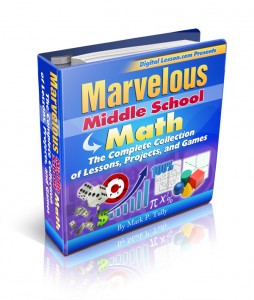
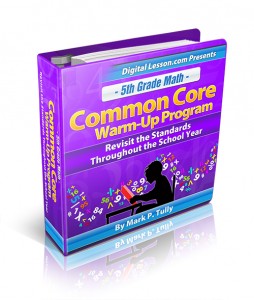
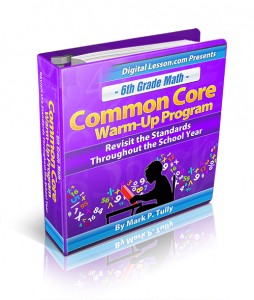
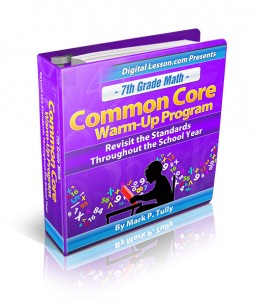
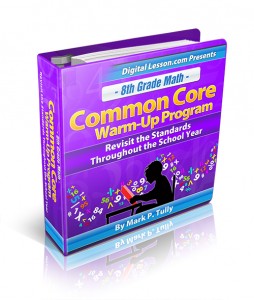




Hello Mark,
What is the name of the program your school purchased? Does it cover the current CA state standards or the new Common Core? Our school has some extra money and we were looking to purchase the “Buckle Down” series – which is in workbook form – but would like to look at another option before we decide. Are the warm ups in the form of a computer program that can be used with a SmartBoard?
Thank you!
Hi Karen,
Thanks for your question.
The program we use is called Star Power Warm-ups: Grade 7 by Jim Wenk. His website is http://www.mathslideshow.com. The warmups cover the current California state standards. They are delivered in a large printed binder that also contains CDs with pdf files that can be projected onto my screen. I use an Airliner, which is a wireless slate from the SmartBoard company, to write on top of them as we correct.
I have been creating supplemental resources for myself and other teachers for over 10 years now. Many teachers across the country use my “Teaching Made Easy As Pi” PowerPoint lessons daily though they are coming under fire recently because of their length. The new push seems to be toward more student partcipation with white boards and less lecture. I am working to concentrate the big ideas into just a few slides rather than guided practice that can extend through 10 – 20 slides.
I know that these warm-ups have made a huge difference not only in test scores but in the strength of my students to apply the concepts to new situations. Everything about them fits well into my program…
1) They quiet down immediately and begin to work.
2) They give me 7 minutes to correct HW and ZAP students who didn’t do it.
3) They review as well as preview concepts.
4) They force me to find a way to explain a new concept in 1 to 2 minutes. You would be surprised how many kids in your class will master the concept from that 2 minute explanation.
5) The Senteo remotes I use allow me to track progress over time and share this with students so they can witness their growth and their own learning.
Great, but why $3000, isn’t that a little much for 650 questions? Yes, as I said, I have sold PPTs to teachers for the last 10 years and over time I have seen my sales turn from 90% district sales/10% teachers sales to the reverse…now 10% district/90% teacher. I feel that this is wrong. I do not want teachers buying this product. If district’s want higher test scores, then they should come up with the funding for it. I had originally priced my warm-ups at $1000 to price it away from the individual teacher, but a principal in my district complained that the price would be over $1 per question, so I went home and tripled the price. You have 10,000 questions in your textbook; how are they working for you? These warm-ups are purposely designed to bring results, and they do just that. Those that are using these warmups know how effective they are, and believe they are well worth the cost of one or two sets of remotes.
James, your warm-ups have been very effective in my math classroom. I highly recommend them for teachers wanting to prepare their students for our California state math test.
Mark,
I too have been using warm-ups in my classroom for the last few years. I gives me an opportunity to see what they have retained, what I need to reteach, or what I don’t need to spend much time on. I call my warm-ups “IPODs” which mean Illinois Problem of the Day. At the beginning of each class I ask the students to get out their IPODs. They understand this to mean the small square cut out with IPOD at the top (I give each student a stack periodically throughout the year). I then put a problem up on the SmartBoard and the students try to solve it. After all of the students have attempted and have an answer written down, we go over the problem and discuss how to reach the correct answer. Students who had the correct answer written down get to put their IPOD into a drawing for a snack at the end of the week. The students really like the fact that a grade is not attached and they can win food for correct answers. It is a no pressure situation for them but gives me a wealth of information.
Joelle, thanks for sharing your warmup system with us! I love how you tell the students to take out their IPODS.